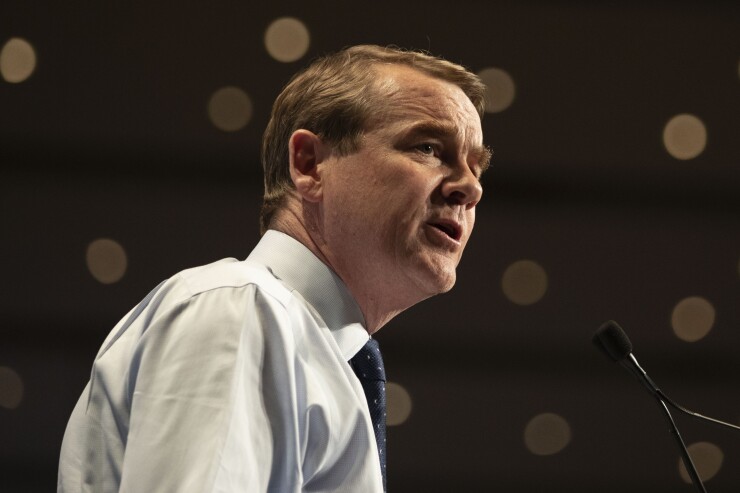A bipartisan proposal to expand the use of tax-exempt private activity bonds to allow their use for carbon capture projects has been reintroduced in the U.S. Senate by Sens. Michael Bennet, D-Colo., and Rob Portman, R-Ohio.
The Carbon Capture Improvement Act was introduced by Bennet in the last two Congresses in 2017 and 2015 with Portman as an original cosponsor.

Under the bill, if more than 65% of carbon dioxide emissions from a given facility are captured and injected underground, then 100% of the eligible equipment can be financed with PABs. If less than 65% is captured and sequestered, then tax-exempt financing is permitted on a prorated basis.
“Reducing carbon pollution while creating good-paying jobs is something that Democrats, Republicans, labor unions, industry, and environmentalists can all get behind,” said Bennet in a press statement. Bennet, who is among more than 20 Democrats who are seeking their party's 2020 nomination for president, said the legislation "would help reduce carbon pollution by making it more cost effective for power plants and industrial facilities to invest in carbon capture equipment.”
Portman called the bill “a win-win for jobs and the environment.”
“Carbon capture is a common-sense solution that will allow states like Ohio to continue to utilize our natural resources while protecting our environment at the same time,” Portman said in a press statement. “This bipartisan measure is supported by business groups, energy groups, and environmental groups alike, and I urge all of my colleagues to support it.”
Although their bill has never advanced through a committee, Bennet and Portman have a timing advantage this year with other lawmakers also introducing bills involving expansion of PABs.
And the politics have changed at least in the House, where all tax-related legislation must originate.
Democratc Rep. Richard Neal of Massachusetts, a former mayor who supports the municipal bond industry, has replaced Republican Rep. Kevin Brady of Texas as chairman of the tax-policy writing House Ways and Means Committee.
Brady notably led the unsuccessful effort by House Republicans in late 2017 to terminate PABs, losing that effort because of pushback from Senate Republicans.
If House Democrats are successful in forging a bipartisan infrastructure bill this year, they have said it would include so-called green infrastructure provisions to address climate change.
The Bennet-Portman PABs expansion fits that mold.
In fact, PABs already have been used to partly finance the largest the world’s largest carbon capture facility at the coal-powered Petra Nova plant in Houston, Texas that became operational on Dec. 29, 2016.
NRG, one of the country's largest power companies, entered into a 50-50 partnership with Japanese oil giant JX Nippon to build Petra Nova after receiving $190 million U.S. Department of Energy grant and qualifying for tax-exempt disaster PABs that were authorized by Congress in the wake of a hurricane that struck Texas in 2008.
According to NRG, “Petra Nova captures carbon dioxide from a 240-megawatt slipstream of flue gas from WA Parish Unit 8—which reduces the amount of greenhouse gases going into the atmosphere from the coal-fueled plant. The captured carbon is then injected into mature reservoirs to release more oil."
“This process revitalizes a diminishing oil field, without involving hydraulic fracturing—creating a significantly more sustainable solution for making the most of existing oil fields.”
Dan Reicher, founding executive director of the Stanford Steyer-Taylor Center for Energy Policy and Finance and a lecturer at Stanford University, said that through his research on Petra Nova he found the key role PABs played in financing the project.
“The origin of this bill is based on that particular project,” Reicher said.
He also researched how the tax reform legislation of 1986 terminated the use of PABs for pollution controls at privately owned power plants which had been successfully used during the 1970s and early 1980s.
“About $100 billion worth of these air pollution control projects got built in today’s dollars,” Reicher said. “So we went to D.C., and basically said why don’t we reopen this tool for a different pollutant, which in this case is carbon dioxide. In the old days it was particulates and sulfur dioxide and all the traditional pollutants. Let’s authorize this old-fashioned tool for carbon dioxide.”
Reicher described PABs as “a very compelling tool for this emerging technology,” which has not yet been completely commercialized.
Two other federal incentives are important, he said. The 45Q tax credit was modified in the 2017 Tax Cuts and Jobs Act for carbon storage or sequestration. Another bill to expand master limited partnerships for energy technology firms is expected to be soon introduced in the House and Senate.
“That’s in fact why these various incentives are important to get it through what we call the valley of death when it comes to commercializing energy technology,” Reicher said.





